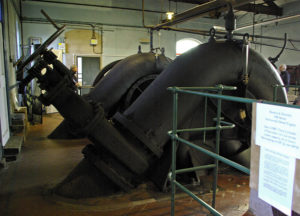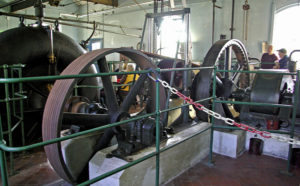The Isle of Axholme is a low lying area bounded by the Rivers Trent, Idle, Torne and Don. These meandered with no real directional flow gradient. The soil was waterlogged and the area used to flood regularly in the winter and was unattractive for farming.
There had been attempts to improve drainage in the Middle Ages with a series of barriers and embankments to control water flow and flooding but these were largely ineffectual. In the C17th the Dutchman Cornelius Vermuyden was commissioned by Charles I to drain and reclaim parts of the Isle of Axholme, so increasing the area of land for cultivation. Vermuyden was to receive one third of the drained land, most of which had been common land. The loss of their common land as well as hunting and fishing rights, made the plans very unpopular with the local population.
His work wasn’t altogether a success as diverting and straightening rivers caused flooding in other areas. Peat also shrunk as it dried resulting in a drop in the land level, in cases to below that of the river.
Further efforts were made to improve drainage in the C18th and C19th with gravity flow of water down drains and dykes and sluice gates controlling the flow of water into the rivers. This worked unless water levels in the rivers were higher than that in the feeder dykes and drainage ditches. During the winter months, flood water in the River Trent could prevent sluice gates being opened for several weeks. The low lying areas around the river flooded regularly.
From the mid C19th pumping stations were built along the Trent using stationary steam engines to pump water into the river.
A small brick pumping station was built on South Street in Owston Ferry in 1910 to improve drainage. It was extended in 1964 for a modern oil engine to replace the earlier steam and diesel engines.
The pumping station was made redundant and was taken over by the Owston Ferry Pumping Engine Preservation Society to preserve it as an example of a once familiar part of the landscape, as well as preserving the engineering skills to look after the engines.
Two large Cornish Steam boilers made by Marshall Sons and Co in Gainsborough provided the power for two steam engines in the main building. The coal came from Rossington Colliery and was brought by train to Haxey and then brought by cart.
These were relatively inefficient compared with other boilers but were easy to maintain and clean and could use any water. Rain water was collected for use, or failing that, water was taken from the drain. The water in the header tank was pre warmed before being fed into the boilers. Normally only one boiler would be needed, except in exceptional circumstances. (Neither of the engines is fit to be used now and are purely a museum exhibit. The Society has bought a small steam boiler which it is restoring to working order.)
The boilers provided steam for two stationary steam engines, again built by Marshalls, in the main building. These worked the two massive Drysdale centrifugal pumps which were capable of moving 90000 litres of water per minute.
By 1952, one of the steam engines was in poor condition and was replaced by a Ruston and Hornsby horizontal diesel engine with two fly wheels. Compressed air is used to start the diesel engine. Once moving and after several revolutions, diesel enters and fires the engine. A belt reduces the speed of the second wheel, allowing the machine to be use with the original pump.
By the 1960s, this was the main pumping engine as the Cornish boilers were no longer able to produce steam.
The pumping station was extended in 1964 to house a small Lister Blackstone vertical oil engine which drove a submerged pump through a Brown gearbox. This engine is still potentially able to pump water.
The Pumping Station is on South Street at the edge of the village and next to the River Trent. It open for a few days each summer when the Ruston and Hornsby diesel engine and Marshall steam engine are run. Otherwise visits can be arranged by contacting the “society.”:http://owstonferrypumpingengine.co.uk/
It is a must for anyone interested in industrial archaeology or the history of the area. There are more pictures “here.”:http://wasleys.org.uk/eleanor/presocialhistory/socialhistory/industrial/owston_pumping/index.html
There is parking by the pumping station. The post code is DN9 1RR and the grid reference is SK 813995.









